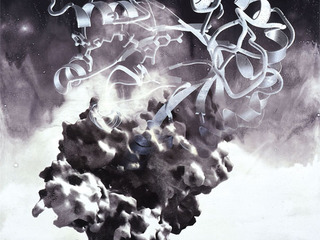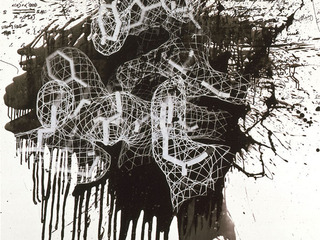New Authorities: Protein by Steve Miller, XSEAD Website
By J.D. Talasek for NAS
April, 2014
Protein is a painting in a series of drawings, paintings, and silkscreens based on the work of Nobel Prize-winning chemist Rod MacKinnon. Some of these paintings were recently displayed at the National Academy of Sciences in an exhibit entitled Crossing the Line curated by Marvin Heiferman.

Signal Relay, 2003. pigment dispersion and silk-screen on canvas, 50 x 37.5 inches, 127 x 96 cm.
Protein is a painting in a series of drawings, paintings, and silkscreens based on the work of Nobel Prize-winning chemist Rod MacKinnon. Some of these paintings were recently displayed at the National Academy of Sciences in an exhibit entitled Crossing the Line curated by Marvin Heiferman.
“For the past decade, Steve Miller has made numerous provocative artworks based upon his collaboration with Rod MacKinnon, a National Academy of Sciences (NAS) member and 2003 Nobel Prize winner for his breakthrough work on the movement of ions across cell membranes. They met at Brookhaven National Laboratory in New York, when Miller, interested in advanced imaging, was working there with scientists and MacKinnon was investigating human protein structures in order to better understand their functioning. In paintings that juxtapose photographic, drawn, and silk-screened images with excerpts from MacKinnon’s notebooks, Miller’s work dissolves conventional distinctions between text and image to explore what distinguishes art from science.”
-from http://www.cpnas.org/exhibitions/archive/crossing-the-line-paintings.html
Transforming Visual Icons
Steve Miller borrowed the visual iconography generated by Dr. MacKinnon—not just the computer-generated models of a cell’s potassium channels, but also silk-screened copies of Dr. MacKinnon’s journal. The handwritten notes and diagrams are embedded into the canvas through silk-screen methods. By changing the context of these visual tools from the lab to the gallery, Miller is generating a new vernacular that can challenge our understanding of proteomics and bioinformatics while asking us to consider their aesthetic importance.
Advancing Arts Practice
How does this work advance art practice? How is this work benefiting science? Sometimes we forget that art inspiration is a very important arc of human inquiry as well. Miller has always been a visually articulate painter, and while he is clearly interested in things coming out of the sciences, he is first and foremost a painter. As an artist, he is interested in exploring these ideas within the canvas.
Artists have always formed several functions within society, but one primary function is to preserve ideas. Art and science are in a dynamic dialogue; the greatest advancements of our times are driven by science and technology and it is natural for artists to want to investigate the impact of these advancements on our social, cultural and personal identity. In doing so, these ideas are being preserved. Here, in addition to the artist’s other objectives, Miller’s series is preserving work by a specific scientist. So it becomes this idea of two people in two different domains having a dialogue that manifests itself in the exhibit space.


